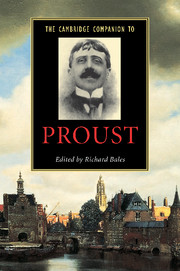Book contents
- Frontmatter
- Introduction
- 1 From Belle Epoque to First World War
- 2 The vast structure of recollection
- 3 Ruskin and the cathedral of lost souls
- 4 The birth and development of A la recherche du temps perdu
- 5 Lost and found: the structure of Proust’s novel
- 6 Proust’s Narrator
- 7 The unconscious
- 8 The texture of Proust’s novel
- 9 Proust’s human comedy
- 10 Proust and social spaces
- 11 Love, sexuality and friendship
- 12 Proust and the fine arts
- 13 Proust and posterity
- Postlude
- Select bibliography
- Index
1 - From Belle Epoque to First World War
Published online by Cambridge University Press: 28 May 2006
- Frontmatter
- Introduction
- 1 From Belle Epoque to First World War
- 2 The vast structure of recollection
- 3 Ruskin and the cathedral of lost souls
- 4 The birth and development of A la recherche du temps perdu
- 5 Lost and found: the structure of Proust’s novel
- 6 Proust’s Narrator
- 7 The unconscious
- 8 The texture of Proust’s novel
- 9 Proust’s human comedy
- 10 Proust and social spaces
- 11 Love, sexuality and friendship
- 12 Proust and the fine arts
- 13 Proust and posterity
- Postlude
- Select bibliography
- Index
Summary
A la recherche du temps perdu spans the period in France between the 1870s and the years of the 1914-18 war, together with an ill-defined post-war period: this represents more or less Proust's own life (1871-1922). Navigational aids are sparse in this work of fiction which is essentially nonlinear and which moves rapidly and often imperceptibly backwards and forwards as in cinematographic flashbacks, but there are occasionally some markers to help the reader traverse the political and social seas. Balzac's aim as a novelist had been to paint a sociological canvas of his time, to produce an inventory of French society in the first half of the nineteenth century. Proust, however, observes and analyses essentially the interior world of his characters set against a background of selected exterior, actual events which provide an authentic sociological backcloth to his novel in the period commencing some twenty years after Balzac's death. As early as 1894, in his introduction to his first published work Les Plaisirs et les jours, he identified the best vantage point for observing social behaviour as from within an enclosed space, in this case Noah’s Ark: ‘Je compris alors que jamais Noé ne put si bien voir le monde que de l’arche, malgré qu’elle fût close et qu’il fît nuit sur la terre’ (JS, p.6). [‘Then it was I understood that Noah could never have had so clear a view of the world as when he gazed upon it from within his ark, sealed though it was, and when darkness was over all the earth’].
- Type
- Chapter
- Information
- The Cambridge Companion to Proust , pp. 7 - 24Publisher: Cambridge University PressPrint publication year: 2001
- 2
- Cited by



